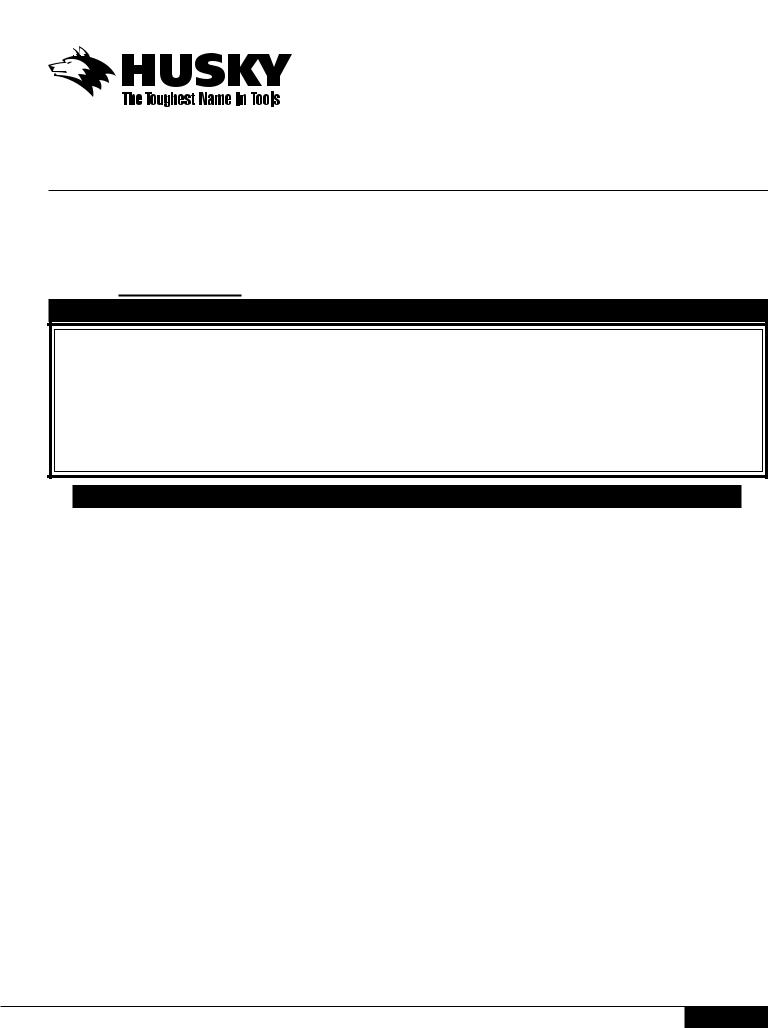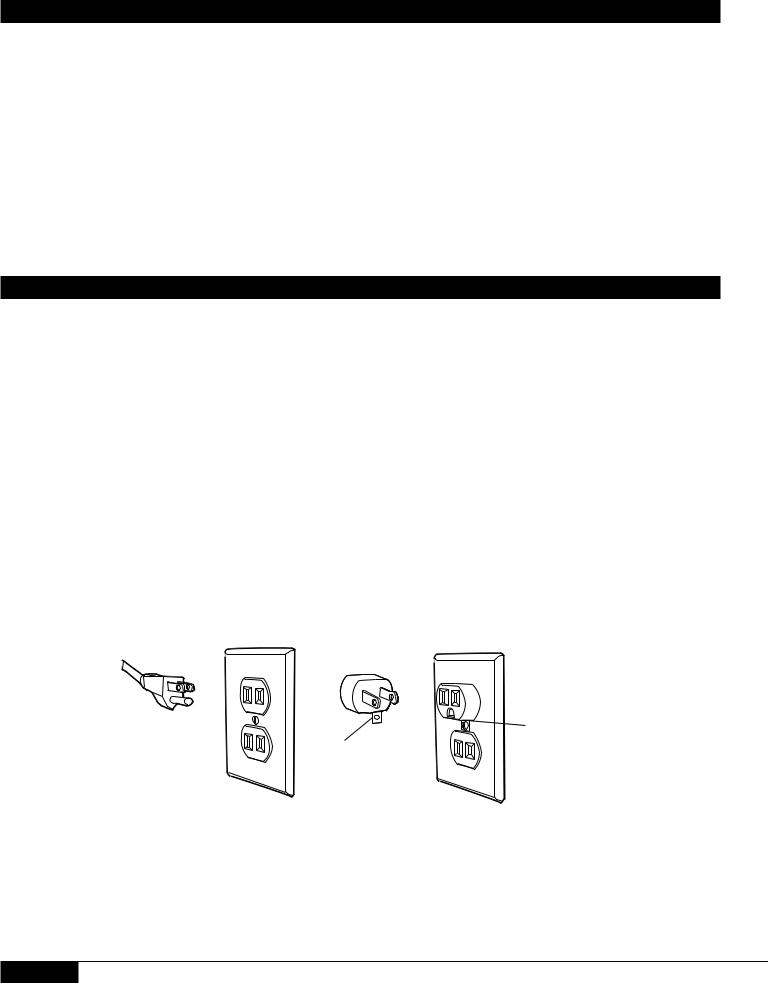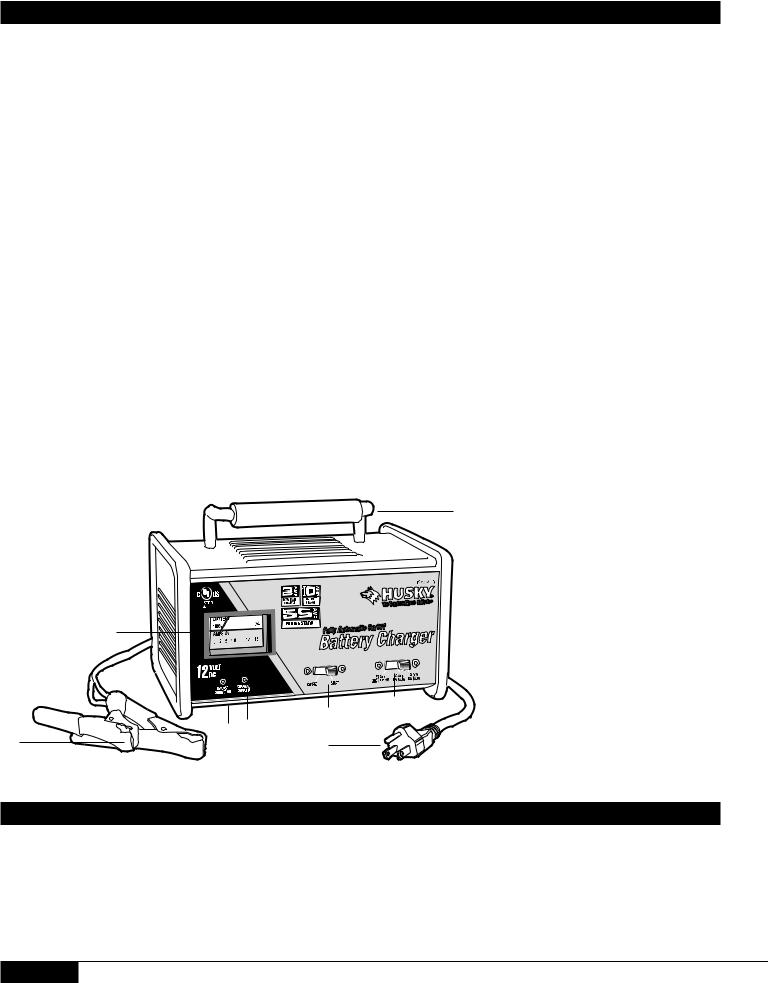Husky HSK074HD user guide

HSK074HD
AUTOMATIC
BATTERY CHARGER
OWNER’S MANUAL & WARRANTY INFORMATION
12 VOLT 2/10 AMPERE WITH 55 / AMPERE START ASSIST
• IMPORTANT SAFETY INSTRUCTIONS •
WARNING – RISK OF EXPLOSIVE GASES
1.WORKING IN VICINITY OF A LEAD-ACID BATTERY IS DANGEROUS. BATTERIES GENERATE EXPLOSIVE GASES DURING NORMAL BATTERY OPERATION. FOR THIS REASON, IT IS OF UTMOST IMPORTANCE THAT EACH TIME BEFORE USING YOUR CHARGER, YOU READ THIS MANUAL AND FOLLOW THE INSTRUCTIONS EXACTLY.
2.To reduce risk of battery explosion, follow these instructions and those published by the battery
manufacturer and manufacturer of any equipment you intend to use in vicinity of battery. Review cautionary markings on these products and on engine.
GENERAL BATTERY SAFETY:
1.Use charger for charging a LEAD-ACID battery only. It is not intended to supply power to a low voltage electrical system other than in automotive applications. Do not use battery charger for charging dry-cell batteries that are commonly used with home and portable appliances. These batteries may burst and cause injury to persons and damage to property.
2.Use of an attachment not recommended or sold by the battery charger manufacturer may result in a risk of fire, electric shock, or injury to persons.
3.To reduce risk of damage to electric plug and cord, pull by plug rather than cord when disconnecting charger.
4.An extension cord should not be used unless absolutely necessary. Use of an improper extension cord could result in a risk of fire and electric shock. If extension cord must be used, make sure:
a.That pins on plug of extension cord are the same number, size, and shape as those of plug on charger.
b.That extension cord is properly wired and in good electrical condition; and
c.That wire size is AWG #18 (18 gauge) to 100 feet and AWG #16 for distances over 100 feet.
5.Do not operate charger with damaged cord or plug - replace the cord or plug immediately.
6.Do not operate charger if it has received a sharp blow, been dropped, or otherwise damaged in any way; take it to a qualified service technician.
7.Do not disassemble charger; take it to a qualified service technician when service or repair is required. Incorrect reassembly may result in a risk of electric shock or fire.
8.To reduce risk of electric shock, unplug charger from outlet before attempting any maintenance or cleaning. Turning off controls will not reduce this risk.
9.Do not expose charger to rain or snow.
10.Never charge a frozen battery.
SAVE THESE INSTRUCTIONS -
This manual contains important safety and operating instructions for battery charger Model HSK074HD
4140 SW 28TH WAY, FT. LAUDERDALE, FL 33312 • TEL: 954-584-4448 • FAX: 954-584-5556 • TOLL-FREE 866-584-5504
1

PERSONAL PRECAUTIONS AND SAFETY
1.Someone should be within range of your voice or close enough to come to your aid when you work near a lead-acid battery.
2.Have plenty of fresh water and soap nearby in case battery acid contacts skin, clothing, or eyes.
3.Wear complete eye protection and clothing protection. Avoid touching eyes while working with a battery. Acid, acid particles or corrosion may get into eyes. Immediately flood eye with running cold water for at least 10 minutes and get medical attention immediately.
4.If battery acid contacts skin or clothing, wash immediately with soap and water.
5.NEVER smoke or allow a spark or flame in vicinity of battery or engine.
6.Be extra cautious to reduce risk of dropping a metal tool onto battery. It might spark or short-circuit battery or other electrical part that may cause explosion.
7.Remove personal metal items such as rings, bracelets, necklaces, and watches when working with a leadacid battery. A lead-acid battery can produce a short-circuit current high enough to weld a ring, or the like to metal causing a severe burn.
GROUND AND AC POWER CORD CONNECTION
Charger should be grounded to reduce risk of electric shock. Charger is equipped with an electric cord having an equipment grounding conductor and a grounding plug. The plug must be plugged into an outlet that is properly installed and grounded in accordance with all local codes and ordinances. (See Figure 1.)
DANGER! NEVER alter AC cord or plug provided – if it will not fit outlet, have proper outlet installed by a qualified electrician. Improper connection can result in the risk of an electric shock.
This battery charger is for use on a nominal 120 volt circuit, has a grounding plug that looks like the plug illustrated in Figure 1. A temporary adapter, which looks like the adapter illustrated in Figures 1 A and B, may be used to connect this plug to a two-pole receptacle as shown in Figure 1 B, if a properly grounded outlet is not available. The temporary adapter should be used only until a properly grounded outlet can be installed by a qualified electrician.
DANGER! Before using adapter as illustrated, be certain that center screw of outlet plate is grounded. The green-colored rigid ear or tab extending from adapter must be connected to a properly grounded outlet– make certain it is grounded. If necessary, replace original outlet cover plate screw with a longer screw that will secure adapter ear or tab to outlet cover plate and make ground connection to grounded outlet.
FIGURE 1
ADAPTER (B)
GROUNDING PIN (A)
METAL SCREW
GROUNDING
MEANS
2

PREPARING TO CHARGE
1.Determine voltage of battery by referring to car owner's manual and make sure that output voltage selector switch is set at correct voltage.
2.If it is necessary to remove battery from vehicle to charge, or to clean terminals, always remove grounded terminal from battery first. Make sure all accessories in the vehicle are off, so as not to cause an arc.
3.Clean battery terminals. Be careful to keep corrosion from coming in contact with eyes.
4.Add distilled water in each cell until battery acid reaches level specified by battery manufacturer. This helps purge excessive gas from cells. Do not overfill. For a battery without cell caps, carefully follow manufacturer's recharging instructions.
5.Study all battery manufacturers' specific precautions such as removing or not removing cell caps while charging and recommended rates of charge.
6.Be sure area around battery is well ventilated while battery is being charged. Gas can be forcefully blown away by using a piece of cardboard or other nonmetallic material such as a fan.
7.Charge battery initially at the 2 Amp (lowest) rate.
CHARGER LOCATION
1.Locate charger as far away from battery as cables permit
2.Never place charger directly above battery being charged; gases from battery will corrode and damage charger.
3.Never allow battery acid to drip on charger when reading gravity or filling battery.
4.Do not operate charger in a closed-in area or restrict ventilation in any way. Marine batteries must be removed and charged on shore.
5.Do not set a battery on top of charger.
DC CONNECTION PRECAUTIONS
1.Connect and disconnect DC output clips only after removing AC cord from electric outlet.
2.Never allow clips to touch each other.
3.Attach clips to battery posts and twist or rock back and forth several times to make a good connection. This tends to keep clips from slipping off terminals and helps to reduce risk of sparking.
FOLLOW THESE STEPS WHEN BATTERY IS INSTALLED IN VEHICLE. A SPARK NEAR BATTERY MAY CAUSE BATTERY EXPLOSION. TO REDUCE RISK OF A SPARK NEAR BATTERY:
a.Position AC and DC cords to reduce risk of damage by hood, door, or moving engine part.
b.Stay clear of fan blades, belts, pulleys, and other parts that can cause injury to persons.
c.Check polarity of battery posts. POSITIVE (POS, P, +) battery post usually has larger diameter than NEGATIVE (NEG, N,-) post.
d.Determine which post of battery is grounded (connected) to the chassis. If negative post is grounded to chassis (as in most vehicles), see (e). If positive post is grounded to the chassis, see (f).
e.For negative-grounded vehicle, connect POSITIVE (RED) clip from battery charger to POSITIVE (POS, P, +) ungrounded post of battery. Connect NEGATIVE (BLACK) clip to vehicle chassis or engine block away from battery. Do not connect clip to carburetor, fuel lines, or sheet-metal body parts. Connect to heavy gauge metal part of the frame or engine block.
f.For positive-grounded vehicle, connect NEGATIVE (BLACK) clip from battery charger to NEGATIVE (NEG, N, -) ungrounded post of battery. Connect POSITIVE (RED) clip to vehicle chassis or engine block away from battery. Do not connect clip to carburetor, fuel lines, or sheet-metal body parts.
Connect to a heavy gauge metal part of the frame or engine block.
g.When disconnecting charger, turn switches to off, disconnect AC cord, remove clip from vehicle chassis, and then remove clip from battery terminal.
h.See operating instructions for length of charge information.
3

INTRODUCTION AND FEATURES
Thank you for selecting the Husky® Model HSK074HD 2/10/55 Battery Charger. With proper care and use, it will give you years of dependable service. Please read all safety warnings and cautions, and this entire User's Manual, before using this device. The manual should then be retained for easy reference whenever the unit is used.
This model battery charger has a high charge rate of up to 10 amps, and low charge rate of up to 2 amps. It is intended for charging only 12 volt lead-acid batteries - maintenance-free, conventional automotive, marine deep cycle - that are usually used in cars, trucks, farm equipment, boats, RVs and SUVs, lawn mowers and garden tractors, motorcycles, personal watercraft, snowmobiles, ATVs, and various light commercial applications. This charger can assist in engine starting by delivering up to 55 amps for up to five minutes.
Charges 12 Volt automotive batteries in only 4-6 hours. Three settings,with sliding power selector:
a)2 amps: 12 volt motorcycle, lawn mower, and Jet Ski type batteries.
b)10 amps: 12 volt automotive, truck and marine deep-cycle batteries.
c)55 Amps for up to five minutes to start engines.
Built-in meter displays charge rate and battery charge level on color-coded, easy-to-read display.
•Automatically taper charges and stops charging when battery is fully charged
•Heavy-duty transformer and rectifier for dependability
•Built-in circuit protection guards against overcharging or short circuit
•Automatically checks for correct polarity (requires a minimum of 4.0 volts at the battery terminals)
•Heavy-duty cables and copper clamps are corrosion-resistant for better connections
•Connect to side–or top-mount battery terminals
•Rugged steel case with baked-on finish, plus sturdy handle
•Ideal for charging or boosting during winter season when the starting performance of vehicle batteries is lowered by cold or extreme weather conditions. (See Figure 2.)
•UL-Listed
FIGURE 2 |
3 |
|
|
|
|
|
1. AMMETER |
|
|
|
|
|
|
2. |
BATTERY CLAMPS |
|
1 |
|
|
|
3. |
HANDLE |
|
|
|
|
4. CHARGE RATE SWITCH |
||
|
|
|
|
|
5. GROUNDED PLUG |
|
|
|
|
|
|
6. |
CHARGE/START SWITCH |
|
|
|
|
|
7. CHARGING COMPLETE LED |
|
|
|
|
6 |
4 |
8. REVERSE CONNECTION LED |
|
|
8 |
7 |
|
|
|
|
2 |
5 |
|
|
|
||
|
|
|
|
|
||
CHARGER CONTROLS
The charger controls are located on the front panel of the charger unit. Familiarize yourself with the controls and their uses, before operating the charger.
CHARGE/START SWITCH
The Charge/Start Switch protects the Ammeter during high current Start conditions and enables the Charge Rate Selector Switch to turn on the Engine Start function. During charge operations, the Charge/Start Switch must be in the Charge (LEFT) position. For starting engines, the Charge/Start Switch is placed in the Start (RIGHT) position.
4
